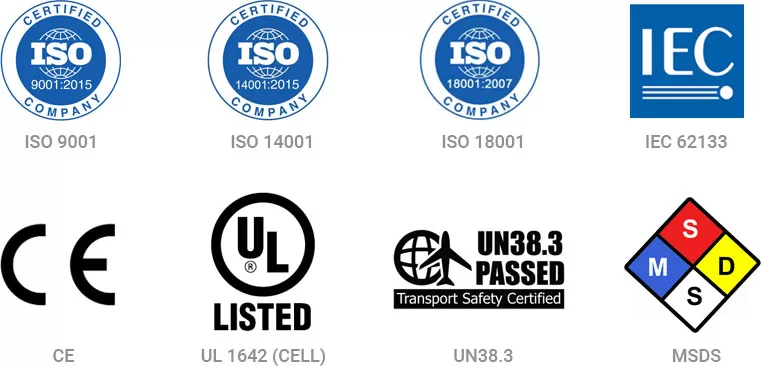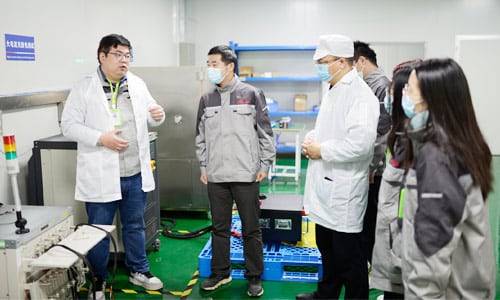Product Cateogries
All-in-One Home ESS
Redway All-in-One Home ESS (Energy Storage System) includes a PWM/MPPT battery charge controller, lithium battery, inverter, fuses and others components, factory wired and packaged into a compact metal case. All you need is to install one of our syatems, simply connect the solar panel(s) to the system. No experience or professional help needed – just follow the manual.
All Redway Products Come with

DIDN’ T FIND WHAT YOU WERE LOOKING FOR?
CUSTOM HOME ESS SOLUTIONS
Redway Battery specializes in providing a diverse selection of battery sizes and configurations to cater to a wide range of applications. Whether you need standard battery options or have unique power requirements, our team of experienced engineers is here to assist you throughout the entire process of designing, developing, testing, and manufacturing custom battery solutions tailored to your specific needs. Feel free to reach out to us today to learn more about our comprehensive range of battery solutions and how we can create a customized solution for you.
DEDICATED FACTORY SUPPORT
Redway Battery is a renowned lithium-ion battery supplier and manufacturer located in China. We specialize in delivering OEM and ODM lithium batteries, catering to potential clients and customers.
By leveraging our combined domestic and international manufacturing capabilities, we are able to produce a diverse range of products that incorporate various cutting-edge technologies, offer flexible pricing options, and ensure timely delivery.
We continually strive to provide high-quality lithium-ion batteries that meet the demands of today’s market.
LEARN BATTERY KNOWLEDGE
At Redway Battery, our team of battery experts is dedicated to sharing comprehensive knowledge about new energy technologies. We are passionate about customizing batteries for a wide range of electronic devices, offering tailored battery solutions, and developing specialized battery solutions. We take pride in providing the most professional and up-to-date information regarding batteries. Our expertise covers a wide range of topics, including battery knowledge, industry news, company updates, informative guides, and more. By staying informed with us, you can access the latest insights and practical information on battery technologies and their applications. Stay connected with us to explore the world of batteries and unlock valuable knowledge and resources.

DOWNLOAD REDWAY PRODUCT BROCHURE AND SPEC
REDWAY PROMISE

QUALITY
6000 TIMES CYCLES
5 YEARS WARRANTY
10 YEARS DESIGN LIFE

CERTIFICATION
ISO9001,ISO14001, OHSAS18001, CE, CB, UL, KC, FCC, BIS, IEC62133.

SERVICES
EXW, FOB, DAP, DDP OPTIONAL T/T, L/C OPTIONAL
Related Knowledge
What is all in one ESS?
- Definition of all-in-one ESS: An all-in-one ESS refers to a plug-and-play power solution that stores and delivers clean electricity. It combines various components, including photovoltaic inverters, batteries, and controllers, into a compact and efficient system.
- Balancing renewable energy sources: All-in-one ESS units play a crucial role in addressing the intermittency of renewable energy sources like solar and wind. By storing excess energy generated during periods of high production, they ensure a consistent and reliable power supply, even when renewable sources are not actively generating electricity.
- Integration and efficiency: The integration of components within an all-in-one ESS unit enables seamless operation and optimized energy management. The compact design enhances space utilization and simplifies installation. These systems are designed to provide clean and reliable electricity while maximizing energy efficiency.
What is the difference between ESS and battery?
- Battery: A battery is a standalone component that stores electric energy as chemical energy and converts it back to electrical energy when required. It is composed of electrochemical cells and serves as a fundamental unit for energy storage.
- Energy Storage System (ESS): An ESS encompasses batteries along with additional components for energy management and distribution. It extends beyond the battery itself and includes systems such as battery management systems, inverters, and control systems. The ESS provides a comprehensive solution for storing, managing, and distributing energy efficiently.
- Comprehensive functionality: While a battery focuses on storing and converting energy, an ESS offers a more holistic approach to energy storage. It incorporates various components and systems to optimize energy management, enhance efficiency, and enable seamless integration with renewable energy sources.
How does an ESS battery work?
- Battery cells: The core component of an ESS battery is the battery cells. These cells are responsible for storing the electrical energy generated from various sources, such as solar panels or the grid. They utilize reversible electrochemical reactions to store and release energy efficiently.
- Battery Management System (BMS): The Battery Management System plays a vital role in ensuring the safe and efficient operation of the ESS battery. It monitors and controls various parameters, such as temperature, voltage, and current, to optimize the performance and longevity of the battery. The BMS also helps prevent overcharging, over-discharging, and other potential issues that can affect the battery’s performance and lifespan.
- Energy storage and utilization: When excess energy is generated, such as during periods of high production from renewable sources like solar panels, the ESS battery stores this surplus energy for later use. This stored energy can then be utilized during periods of low energy production or high energy consumption, ensuring a consistent and reliable power supply.
What is the difference between UPS and ESS?
- UPS (Uninterruptible Power Supply): A UPS is primarily designed as an emergency backup power supply. It serves as a temporary power source that activates when the main power supply fails. UPS systems provide instantaneous power to critical loads, ensuring uninterrupted operation during power outages. They are commonly used in settings where power continuity is crucial, such as data centers, hospitals, and critical infrastructure.
- ESS (Energy Storage System): An ESS focuses on energy storage and management. It aims to efficiently store electrical energy for later use and optimize its utilization. ESS systems integrate various components, such as batteries, inverters, and control systems, to store and distribute energy effectively. They are utilized in applications where energy management, load shifting, and renewable energy integration are essential, such as residential and commercial settings.
- Purpose and usage: The primary purpose of a UPS is to provide immediate backup power during power outages, ensuring uninterrupted operation for critical loads. On the other hand, an ESS focuses on long-term energy storage, load shifting, and energy management. It enables efficient utilization of stored energy, optimizing energy consumption and reducing reliance on the main power grid.
What is ESS charging?
- Storing energy for later use: ESS charging involves the process of storing energy in an Energy Storage System (ESS) for later use. During off-peak hours, when electricity rates are lower, the ESS charges by storing energy from renewable sources like solar panels. This allows for the efficient utilization of energy generated during times of low demand.
- Utilizing stored energy: The stored energy in the ESS can be utilized during peak hours or when there is a high demand for electricity. This includes charging electric vehicles, powering appliances, or supplying energy to critical loads. ESS charging ensures a consistent and reliable power supply, even during periods of high energy consumption.
- Optimizing energy balance: ESS charging helps optimize the balance between energy generation and consumption. By storing excess energy during off-peak hours, the ESS can supply power during peak hours, reducing the strain on the main power grid. This not only helps in cost savings but also promotes the integration of renewable energy sources into the overall energy system.
What is the voltage of ESS?
- Voltage variability: The voltage of an ESS can vary depending on the specific system and application. ESS batteries are available in a range of voltage levels, including low voltage and high voltage options. The choice of voltage depends on factors such as the battery technology used, the desired capacity, and the requirements of the application.
- Battery technology and voltage: The voltage of an ESS is closely tied to the battery technology employed. Different battery chemistries and designs operate at varying voltage levels. For example, lithium-ion batteries typically operate at higher voltages compared to lead-acid batteries. It is essential to select an ESS with a voltage compatible with the application and other system components.
- System integration and compatibility: When considering an ESS for a specific application, it is crucial to ensure voltage compatibility with other system components. This includes inverters, charge controllers, and electrical loads. Proper voltage matching ensures efficient energy transfer and safe operation of the entire system.
What are the disadvantages of ESS?
- High initial costs: One of the primary disadvantages of ESS is the high initial investment required for installation and maintenance. The cost of purchasing and installing the necessary components, such as batteries, inverters, and control systems, can be significant. This can pose a financial challenge, especially for larger-scale ESS applications.
- Limited storage capacity: Another drawback of ESS is the limited storage capacity of the system. The amount of energy that can be stored in the ESS depends on factors such as the battery technology used and the physical size of the system. In some cases, the storage capacity may not be sufficient to meet the energy demands of certain applications, requiring careful management of energy usage.
- Limited lifespan: ESS systems have a finite lifespan, which means that they will eventually require replacement or refurbishment. The lifespan of an ESS depends on various factors, including the type of battery technology used and the operating conditions. It is important to consider the lifespan of the system when evaluating the long-term viability and cost-effectiveness of implementing ESS.
How much does ESS energy storage cost?
- System capacity and specifications: The cost of ESS energy storage is influenced by the capacity and specifications of the system. Larger capacity systems with higher energy storage capabilities generally come with a higher price tag. Additionally, the specific requirements of the application, such as power output and discharge rates, can impact the overall cost.
- Battery technology: The choice of battery technology plays a significant role in determining the cost of ESS energy storage. Different battery chemistries and designs have varying costs associated with them. For example, lithium-ion batteries are commonly used in ESS systems but tend to have higher upfront costs compared to lead-acid batteries.
- Application requirements: The cost of ESS energy storage is also influenced by the specific requirements of the application. Different industries and sectors may have unique energy storage needs, which can impact the overall cost. For instance, grid-scale ESS installations may require larger and more complex systems, leading to higher costs compared to residential or commercial applications.

